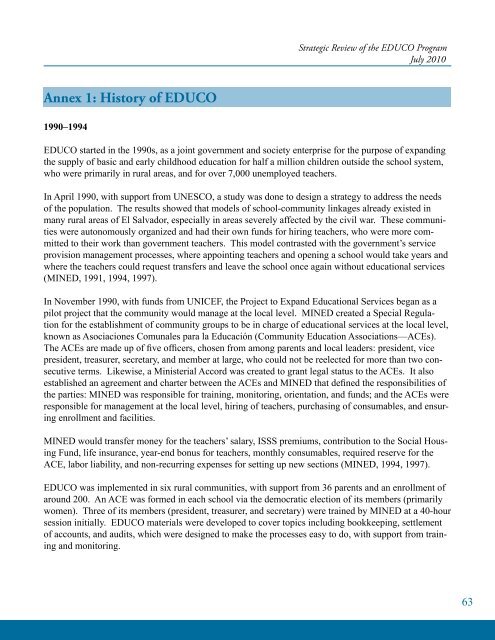Strategic Review of the EDUCO Program - EQUIP123.net
Strategic Review of the EDUCO Program - EQUIP123.net
Strategic Review of the EDUCO Program - EQUIP123.net
You also want an ePaper? Increase the reach of your titles
YUMPU automatically turns print PDFs into web optimized ePapers that Google loves.
<strong>Strategic</strong> <strong>Review</strong> <strong>of</strong> <strong>the</strong> <strong>EDUCO</strong> <strong>Program</strong>July 2010Annex 1: History <strong>of</strong> <strong>EDUCO</strong>1990–1994<strong>EDUCO</strong> started in <strong>the</strong> 1990s, as a joint government and society enterprise for <strong>the</strong> purpose <strong>of</strong> expanding<strong>the</strong> supply <strong>of</strong> basic and early childhood education for half a million children outside <strong>the</strong> school system,who were primarily in rural areas, and for over 7,000 unemployed teachers.In April 1990, with support from UNESCO, a study was done to design a strategy to address <strong>the</strong> needs<strong>of</strong> <strong>the</strong> population. The results showed that models <strong>of</strong> school-community linkages already existed inmany rural areas <strong>of</strong> El Salvador, especially in areas severely affected by <strong>the</strong> civil war. These communitieswere autonomously organized and had <strong>the</strong>ir own funds for hiring teachers, who were more committedto <strong>the</strong>ir work than government teachers. This model contrasted with <strong>the</strong> government’s serviceprovision management processes, where appointing teachers and opening a school would take years andwhere <strong>the</strong> teachers could request transfers and leave <strong>the</strong> school once again without educational services(MINED, 1991, 1994, 1997).In November 1990, with funds from UNICEF, <strong>the</strong> Project to Expand Educational Services began as apilot project that <strong>the</strong> community would manage at <strong>the</strong> local level. MINED created a Special Regulationfor <strong>the</strong> establishment <strong>of</strong> community groups to be in charge <strong>of</strong> educational services at <strong>the</strong> local level,known as Asociaciones Comunales para la Educación (Community Education Associations—ACEs).The ACEs are made up <strong>of</strong> five <strong>of</strong>ficers, chosen from among parents and local leaders: president, vicepresident, treasurer, secretary, and member at large, who could not be reelected for more than two consecutiveterms. Likewise, a Ministerial Accord was created to grant legal status to <strong>the</strong> ACEs. It alsoestablished an agreement and charter between <strong>the</strong> ACEs and MINED that defined <strong>the</strong> responsibilities <strong>of</strong><strong>the</strong> parties: MINED was responsible for training, monitoring, orientation, and funds; and <strong>the</strong> ACEs wereresponsible for management at <strong>the</strong> local level, hiring <strong>of</strong> teachers, purchasing <strong>of</strong> consumables, and ensuringenrollment and facilities.MINED would transfer money for <strong>the</strong> teachers’ salary, ISSS premiums, contribution to <strong>the</strong> Social HousingFund, life insurance, year-end bonus for teachers, monthly consumables, required reserve for <strong>the</strong>ACE, labor liability, and non-recurring expenses for setting up new sections (MINED, 1994, 1997).<strong>EDUCO</strong> was implemented in six rural communities, with support from 36 parents and an enrollment <strong>of</strong>around 200. An ACE was formed in each school via <strong>the</strong> democratic election <strong>of</strong> its members (primarilywomen). Three <strong>of</strong> its members (president, treasurer, and secretary) were trained by MINED at a 40-hoursession initially. <strong>EDUCO</strong> materials were developed to cover topics including bookkeeping, settlement<strong>of</strong> accounts, and audits, which were designed to make <strong>the</strong> processes easy to do, with support from trainingand monitoring.63

















